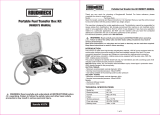
4
MAINTENANCE /
REPAIR
TROUBLESHOOTING OPERATION GETTING STARTED
ASSEMBLY /
INSTALLATION
SAFETY /
SPECIFICATIONS
GENERAL SAFETY INSTRUCTIONS
IMPORTANT: It is your responsibility to:
• Know and follow applicable national, state and local safety codes
pertaining to installing and operating electrical equipment for use with
flammable liquids.
• Know and follow all safety precautions when handling petroleum fuels.
• Ensure that all equipment operators have access to adequate
instructions concerning safe operating and maintenance procedures.
Observe all safety precautions concerning safe handling of petroleum fuels.
To ensure safe operation, all fuel transfer systems
must be properly grounded. Proper grounding
means a continuous metal-to-metal contact from one component to
the next, including tank, tank mount, pump, meter, filter, hose and
nozzle. Care should be taken to ensure proper grounding during initial
installation and after any service or repair procedures. For your
safety, please take a moment to review the warnings below.
To prevent physical injury or property damage,
observe precautions against fire or explosion
when dispensing fuel. Do not operate the system in the presence
of any source of ignition including running or hot engines, lighted
tobacco products, gas or electric heaters, or any type of electronic
device. A spark can ignite fuel vapors.
Observe precautions against electrical shock
when operating the system. Serious or fatal
shock can result from operating electrical equipment in damp
or wet locations.
Inspect external pump wiring regularly to
make sure it is correctly attached to the battery.
To avoid electrical shock, use extra care when connecting the
pump to power.
Avoid prolonged skin contact with petroleum
fuels. Use protective goggles, gloves and aprons
in case of splashing or spills. Change saturated clothing and wash
skin promptly with soap and water.
Observe precautions against electrical shock
when servicing the pump. Always disconnect
power before repairing or servicing. Never apply electrical power
to the system when any of the coverplates are removed.
If using solvent to clean pump components
or tank, observe the solvent manufacturer’s
recommendations for safe use and disposal.




























